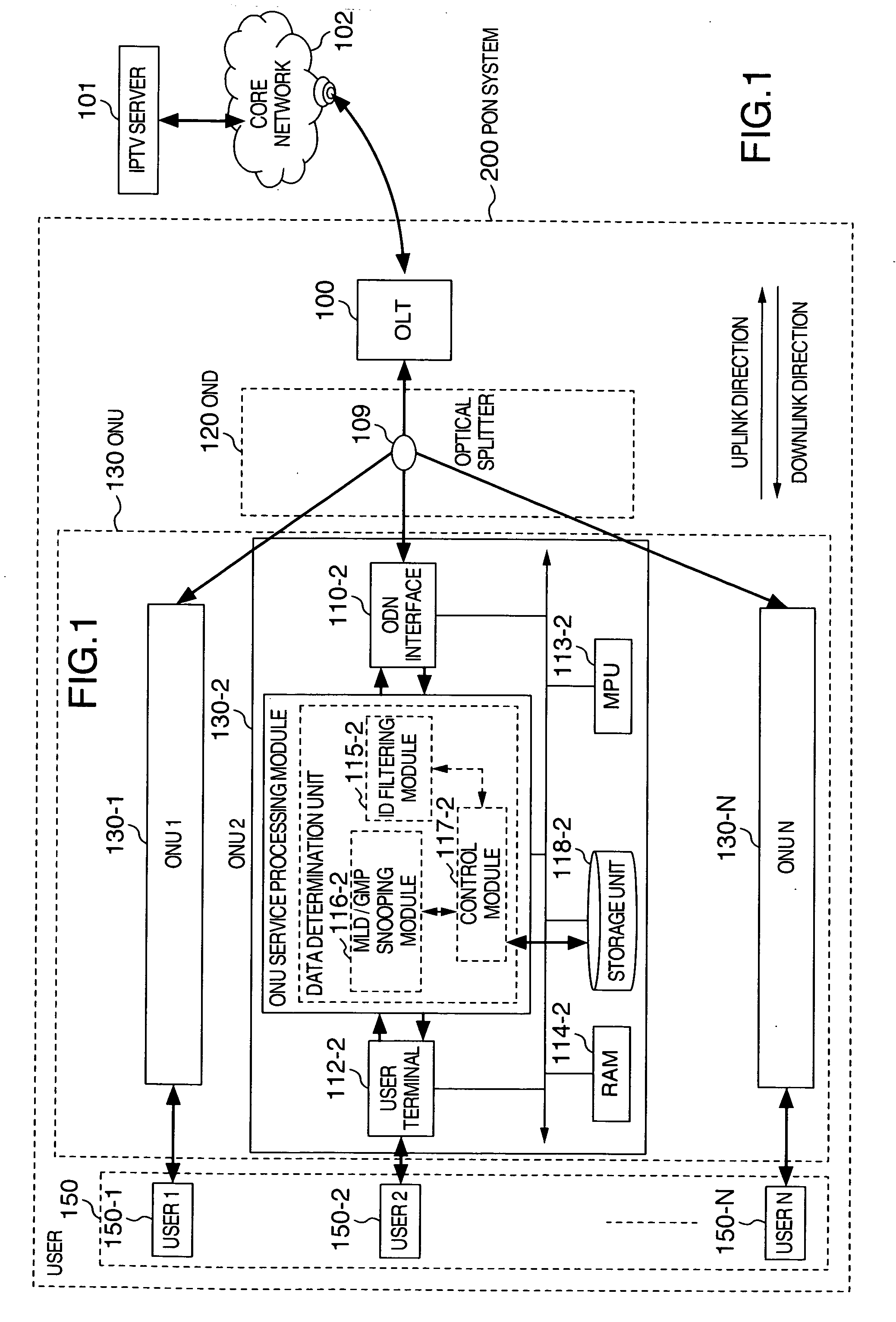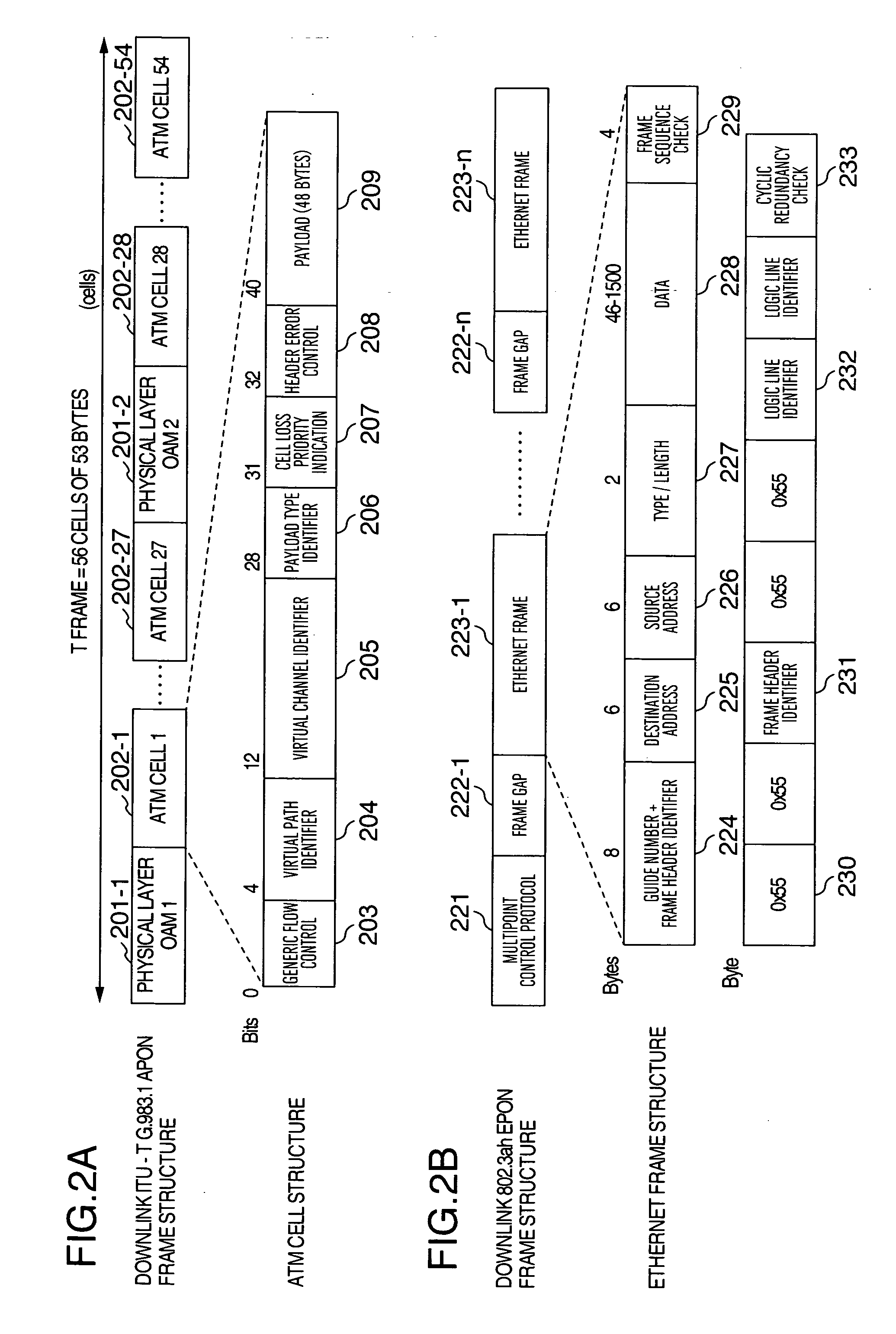Storage function method and apparatus in a passive optical network
a technology of passive optical network and storage function, which is applied in the field of storage function methods and equipment for implementing a storage function in a passive optical network system, can solve the problems of large downlink flow of this system, inability to solve the problem of bandwidth waste in the connection network (such as pon) portion of downlink bandwidth, and achieve the effect of improving the utilization factor
- Summary
- Abstract
- Description
- Claims
- Application Information
AI Technical Summary
Benefits of technology
Problems solved by technology
Method used
Image
Examples
first embodiment
[0041]Hereinafter, an explanation will be given specifically of a passive optical network system of Embodiment 1 of the present invention, on the basis of FIGS. 1 to 4.
[0042]FIG. 1 is a structural frame diagram of a passive optical network system 200 having a storage function of Embodiment 1 of the present invention. In PON system 200, there are included an optical line terminal (below abbreviated as “OLT”) 100 connected to a core network 102 which is connected to an IPTV server 101, an optical distribution network (below abbreviated as “ODN”) 120 connected to OLT 100, and multiple optical network units (below abbreviated as “ONU”) 130-1, 130-2, . . . , 130-N (N expressing a positive integer greater than 1; below named generically as “ONU 130”) connected to ODN 120, and the like.
[0043]In ODN 120 therein, there is included an optical splitter 109. OLT 100 is located in a station terminal, and ONU 130, which is placed locally, shares an optical fiber located between OLT 100 and optica...
second embodiment
[0078]Based on FIG. 5 to FIG. 8, an explanation will hereinafter be given specifically regarding the data storage method of a passive optical network system of Embodiment 2 of the present invention.
[0079]FIG. 5 is a flowchart for storing, in the ONU storage device, data requiring storage in the downlink data, and for transferring data stored based on a user request.
[0080]First, by means of predetermined rules, data making exclusive use of a comparatively large bandwidth, such as e.g. audiovisual data and large data packages, are judged, from among all the data that have gradually been sent, to be data requiring storage (Step 501), on the basis of the LINK ID of the data. Thereafter, the previously determined data requiring storage are stored in storage device 118 of ONU 130 (Step 502). Supposing that it is the case that user 150 connected to ONU 130 had requested the data stored in storage device 118, the stored data are transferred directly to user 150 and if a request is made for ...
third embodiment
[0094]Based on FIG. 9 to FIG. 11, an explanation will hereinafter be given specifically regarding an OLT in a PON system of Embodiment 3 of the present invention.
[0095]FIG. 9 is a structural frame diagram of an OLT 100 having a groupcast LINK ID allocation module allocating groupcast LINK IDs with respect to the data. In OLT 100, there are mainly included an ODN interface 105, an OLT function processing module 104, a service terminal 103, a microprocessor unit (MPU) 106, a built-in read / write memory (RAM) 107, and the like. In the aforementioned OLT function processing module 104, there is included a groupcast LINK ID allocation module 108, and in this way, groupcast LINK IDs are allocated to data requiring storage (e.g. data making exclusive use of a comparatively wide bandwidth such as audiovisual data and large data packages). In case OLT function processing module 104 has detected data requiring storage coming from the IPTV server, one groupcast LINK ID is allocated to these dat...
PUM
 Login to View More
Login to View More Abstract
Description
Claims
Application Information
 Login to View More
Login to View More - R&D
- Intellectual Property
- Life Sciences
- Materials
- Tech Scout
- Unparalleled Data Quality
- Higher Quality Content
- 60% Fewer Hallucinations
Browse by: Latest US Patents, China's latest patents, Technical Efficacy Thesaurus, Application Domain, Technology Topic, Popular Technical Reports.
© 2025 PatSnap. All rights reserved.Legal|Privacy policy|Modern Slavery Act Transparency Statement|Sitemap|About US| Contact US: help@patsnap.com



